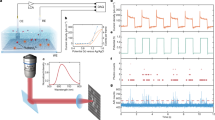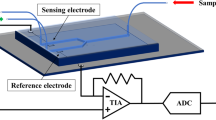Abstract
The success of single-molecule (SM) experiments critically depends on the functional immobilization of the biomolecule(s) to be studied. With the continuing trend of combining SM fluorescence with SM force experiments, methods are required that are suitable for both types of measurements. We describe a general protocol for the site-specific and covalent coupling of any type of biomolecule that can be prepared with a free thiol group. The protocol uses a poly(ethylene glycol) (PEG) spacer, which carries an N-hydroxy succinimide (NHS) group on one end and a maleimide group on the other. After reacting the NHS group with an amino-functionalized surface, the relatively stable but highly reactive maleimide group allows the coupling of the biomolecule. This protocol provides surfaces with low fluorescence background, low nonspecific binding and a large number of reactive sites. Surfaces containing immobilized biomolecules can be obtained within 6 h.
This is a preview of subscription content, access via your institution
Access options
Subscribe to this journal
Receive 12 print issues and online access
$259.00 per year
only $21.58 per issue
Buy this article
- Purchase on Springer Link
- Instant access to full article PDF
Prices may be subject to local taxes which are calculated during checkout



Similar content being viewed by others
References
Ishijima, A. et al. Simultaneous observation of individual ATPase and mechanical events by a single myosin molecule during interaction with actin. Cell 92, 161–171 (1998).
Lang, M.J., Fordyce, P.M., Engh, A.M., Neuman, K.C. & Block, S.M. Simultaneous, coincident optical trapping and single-molecule fluorescence. Nat. Methods 1, 133–139 (2004).
Kodama, T., Ohtani, H., Arakawa, H. & Ikai, A. Mechanical perturbation-induced fluorescence change of green fluorescent protein. Appl. Phys. Lett. 86, 043901 (2005).
Owen, R.J., Heyes, C.D., Knebel, D., Rocker, C. & Nienhaus, G.U. An integrated instrumental setup for the combination of atomic force microscopy with optical spectroscopy. Biopolymers 82, 410–414 (2006).
Kufer, S.K., Puchner, E.M., Gumpp, H., Liedl, T. & Gaub, H.E. Single-molecule cut-and-paste surface assembly. Science 319, 594–596 (2008).
Gumpp, H., Stahl, S.W., Strackharn, M., Puchner, E.M. & Gaub, H.E. Ultrastable combined atomic force and total internal fluorescence microscope. Rev. Sci. Instrum. 80, 063704 (2009).
Puchner, E.M., Kufer, S.K., Strackharn, M., Stahl, S.W. & Gaub, H.E. Nanoparticle self-assembly on a DNA-scaffold written by single-molecule cut-and-paste. Nano Lett. 8, 3692–3695 (2008).
Kufer, S.K. et al. Optically monitoring the mechanical assembly of single molecules. Nat. Nanotechnol. 4, 45–49 (2009).
Gumpp, H. et al. Triggering enzymatic activity with force. Nano Lett. 9, 3290–3295 (2009).
Hinterdorfer, P. & Dufrene, Y.F. Detection and localization of single molecular recognition events using atomic force microscopy. Nat. Methods 3, 347–355 (2006).
Roy, R., Hohng, S. & Ha, T. A practical guide to single-molecule FRET. Nat. Methods 5, 507–516 (2008).
Berquand, A. et al. Antigen binding forces of single antilysozyme Fv fragments explored by atomic force microscopy. Langmuir 21, 5517–5523 (2005).
Mather, B.D., Viswanathan, K., Miller, K.M. & Long, T.E. Michael addition reactions in macromolecular design for emerging technologies. Prog. Polym. Sci. 31, 487–531 (2006).
Oesterhelt, F., Rief, M. & Gaub, H.E. Single molecule force spectroscopy by AFM indicates helical structure of poly(ethylene-glycol) in water. New J. Phys. 1, 6.1–6.11 (1999).
Morfill, J. et al. Affinity-matured recombinant antibody fragments analyzed by single-molecule force spectroscopy. Biophys. J. 93, 3583–3590 (2007).
Jeon, S.I., Lee, J.H., Andrade, J.D. & Degennes, P.G. Protein surface interactions in the presence of polyethylene oxide. 1. Simplified theory. J. Colloid Interface Sci. 142, 149–158 (1991).
Sofia, S.J. & Merrill, E.W. Protein adsorption on poly(ethylene oxide)-grafted silicon surfaces. In Poly(ethylene glycol) Chemistry and Biological Applications (eds. Harris J.M. & Zalipsky, S.) Ch. 22, 342–360 (ACS Symposium Series, Washington, D.C., 1997).
Alcantar, N.A., Aydil, E.S. & Israelachvili, J.N. Polyethylene glycol-coated biocompatible surfaces. J. Biomed. Mater. Res. 51, 343–351 (2000).
Ebner, A., Hinterdorfer, P. & Gruber, H.J. Comparison of different aminofunctionalization strategies for attachment of single antibodies to AFM cantilevers. Ultramicroscopy 107, 922–927 (2007).
Canalle, L.A., Löwik, D.W. & van Hest, J.C. Polypeptide-polymer bioconjugates. Chem. Soc. Rev. 39, 329–353 (2010).
Medintz, I.L., Uyeda, H.T., Goldman, E.R. & Mattoussi, H. Quantum dot bioconjugates for imaging, labelling and sensing. Nat. Mater. 4, 435–446 (2005).
Rusmini, F., Zhong, Z. & Feijen, J. Protein immobilization strategies for protein biochips. Biomacromolecules 8, 1775–1789 (2007).
Collings, A.F. & Caruso, F. Biosensors: recent advances. Rep. Prog. Phys. 60, 1397–1445 (1997).
Nicu, L. & Leichle, T. Biosensors and tools for surface functionalization from the macro-to the nanoscale: The way forward. J. Appl. Phys. 104, 111101 (2008).
Burns, J.A., Butler, J.C., Moran, J. & Whitesides, G.M. Selective reduction of disulfides by Tris(2-carboxyethyl)phosphine. J. Org. Chem. 56, 2648–2650 (1991).
Blank, K., Morfill, J. & Gaub, H.E. Site-specific immobilization of genetically engineered variants of Candida antarctica lipase B. Chembiochem 7, 1349–1351 (2006).
Morfill, J. et al. Force-based analysis of multidimensional energy landscapes: application of dynamic force spectroscopy and steered molecular dynamics simulations to an antibody fragment-peptide complex. J. Mol. Biol. 381, 1253–1266 (2008).
Velonia, K., Rowan, A.E. & Nolte, R.J.M. Lipase polystyrene giant amphiphiles. J. Am. Chem. Soc. 124, 4224–4225 (2002).
Hermanson, G.T. Bioconjugate Techniques (Elsevier, London, 2008).
Knappik, A. & Plückthun, A. An improved affinity tag based on the FLAG peptide for the detection and purification of recombinant antibody fragments. Biotechniques 17, 754–761 (1994).
Zahnd, C. et al. Directed in vitro evolution and crystallographic analysis of a peptide-binding single chain antibody fragment (scFv) with low picomolar affinity. J. Biol. Chem. 279, 18870–18877 (2004).
Kühner, F., Morfill, J., Neher, R.A., Blank, K. & Gaub, H.E. Force-induced DNA slippage. Biophys. J. 92, 2491–2497 (2007).
Morfill, J. et al. B-S transition in short oligonucleotides. Biophys. J. 93, 2400–2409 (2007).
Neuert, G., Albrecht, C., Pamir, E. & Gaub, H.E. Dynamic force spectroscopy of the digoxigenin-antibody complex. FEBS Lett. 580, 505–509 (2006).
Acknowledgements
We thank Hermann E. Gaub and all members of the Gaub lab for using the protocol in various SM experiments and for many valuable discussions leading to continuous improvements of the protocol. This work was supported by the German Research Foundation (DFG) and the European Union.
Author information
Authors and Affiliations
Contributions
T.N. and G.N. developed the silanization protocols; J.L.Z. and K.B. developed the coupling procedures for the biomolecules; G.N. and J.L.Z. carried out SM experiments; and J.L.Z. and K.B. wrote the paper.
Corresponding author
Ethics declarations
Competing interests
The authors declare no competing financial interests.
Rights and permissions
About this article
Cite this article
Zimmermann, J., Nicolaus, T., Neuert, G. et al. Thiol-based, site-specific and covalent immobilization of biomolecules for single-molecule experiments. Nat Protoc 5, 975–985 (2010). https://doi.org/10.1038/nprot.2010.49
Published:
Issue Date:
DOI: https://doi.org/10.1038/nprot.2010.49
This article is cited by
-
Isocyanide-based multi-component reactions for carrier-free and carrier-bound covalent immobilization of enzymes
Nature Protocols (2023)
-
Anisotropy in mechanical unfolding of protein upon partner-assisted pulling and handle-assisted pulling
Communications Biology (2021)
-
Towards a Quantitative Understanding of Protein–Lipid Bilayer Interactions at the Single Molecule Level: Opportunities and Challenges
The Journal of Membrane Biology (2021)
-
Multiple stochastic pathways in forced peptide-lipid membrane detachment
Scientific Reports (2019)
-
Enzymatic biosynthesis and immobilization of polyprotein verified at the single-molecule level
Nature Communications (2019)
Comments
By submitting a comment you agree to abide by our Terms and Community Guidelines. If you find something abusive or that does not comply with our terms or guidelines please flag it as inappropriate.



